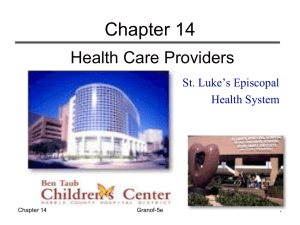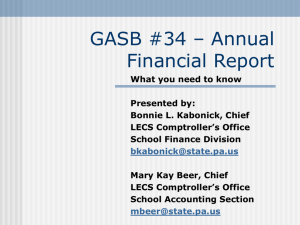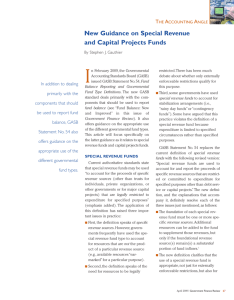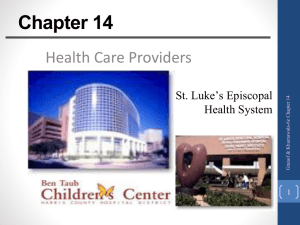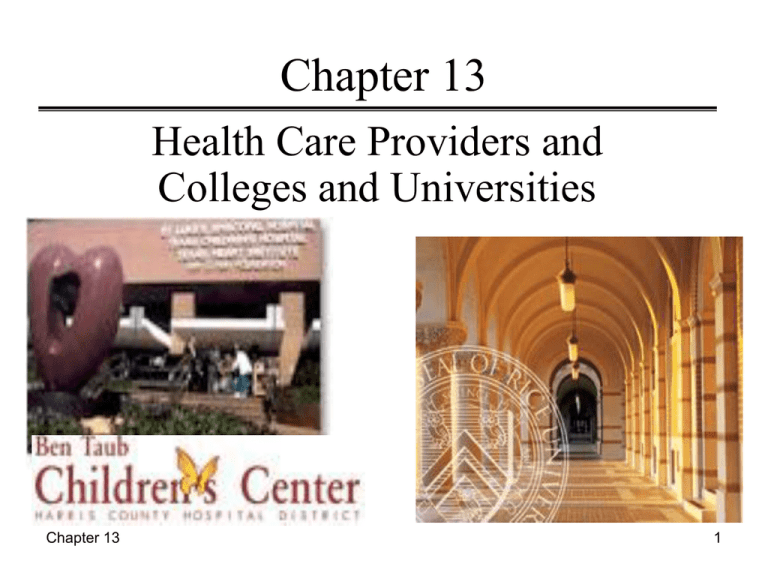
Chapter 13
Health Care Providers and
Colleges and Universities
Chapter 13
1
Learning Objectives
Understand the unique issues faced by not-for-profit health
care providers and colleges and universities (C&U)
Understand accounting and reporting issues for healthcare
providers such as accounting for:
– Revenues and expenses
– Fee for service revenues
– Capitation revenues
– Bad debts and charity care
– Malpractice claims
– “Retrospective” insurance premiums
Chapter 13
2
Learning Objectives (cont’d)
Understand the reporting options available to government C&U and
the differences in financial reporting for government C&U and not-forprofit C&U.
Discuss accounting and reporting issues for all C&U, such as
accounting for
– Revenues and expenses
– Tuition and fees
– Grants
– Student Loans
– Special concerns related to auxiliary enterprises
Journalize transactions and prepare financial statements for
governmentally owned C&U following GASB Statement No. 35.
Prepare financial statements for private colleges and universities
following SFAS Statement No. 117.
Chapter 13
3
Health Care Organizations, such as
Hospitals, can be structured as
For-Profit:
Proprietary
Chapter 13
Not-for-Profit:
Voluntary
Governmental:
Public
4
Examples of Health Care Organizations
Not-for-Profit: St. Luke’s Health
System and Memorial Hermann
Healthcare system in Houston.
For-profit: HealthSouth
Governmental: M.D. Anderson
Cancer Center in Houston.
Chapter 13
5
Health Care Organizations (HCOs)
Types of Services:
Chapter 13
Clinics and individual (or group) practices
Continuing care retirement communities (CCRC)
Health maintenance organizations (HMOs)
Home health agencies, e.g., hospice
Hospitals
Nursing homes
Rehabilitation centers
6
GAAP for HCOs
Governmental health care organizations will now follow GASB
Statement No. 34, and are considered special purpose governments.
Governmental health care entities may be accounted for as a part of a
governmental unit (i.e., as a special revenue, internal service, or
enterprise fund) or as a stand-alone business-type activity that uses
proprietary fund accounting principles.
All health care organizations follow the AICPA industry audit guide,
Health Care Organizations as Category (b) authority after applying all
appropriate FASB and GASB Statements.
This guidance includes:
-using full accrual accounting
-capitalizing long-lived assets
-depreciating those capital assets
Chapter 13
7
Accounting Issues that differ depending upon the
Organizational Structure (Government v/s NFP HCO)
reporting entity
contributions
financial statement display
cash flows
deposits and investments (i.e., see GASB
Statement No. 31, SFAS No. 115, and SFAS
No. 124)
operating leases
compensated absences
debt refunding; risks and uncertainties
pensions and other post retirement benefits
Chapter 13
8
Financial Statements for HCOs
Balance Sheet (Table 13-1A)
Statement of Activities (Table 13-1B)
Statement of Changes in Net Assets
(Table 13-1C)
Statement of Cash Flows (Table 13-1D)
Chapter 13
9
Statements of Cash Flows
NFP and For-Profit HCO
Authority SFAS No. 95
Governmental HCO
GASB Statement No. 9
Activities Operating
Investing
Financing
Interest paid and
received
PPE Acquisition
Unrestricted gifts
Operating
Investing
Noncapital financing
Capital and related
financing
Operating, except restricted net Investing
asset income (financing)
Investing
Capital and related
financing
Operating
Noncapital financing
Reconciliation Net assets to operating
schedule activities
Chapter 13
Operating income(loss) to
operating activities
10
Fund Accounting (for governmental
HCOs or for internal purposes)
For purposes of internal accounting, HCOs have:
General Unrestricted Funds
-Reports financial resources and fixed assets.
Donor-Restricted Funds (both temporarily and
permanently restricted):
- Specific Purpose Fund
- Plant Replacement and Expansion Fund
- Endowments
Chapter 13
11
Revenues - HCOs
Revenues are categorized as:
– Unrestricted
– Temporarily restricted, and
– Permanently restricted
Unrestricted revenues:
– Patient care revenues
– Other revenues
Chapter 13
12
Principle Sources of Revenue for a HCO:
Patient service revenue
Premium revenue from capitation fees
(i.e. fixed fees per person paid
periodically regardless of services provided)
Resident service revenue (e.g., maintenance or rental fees)
Other revenue (e.g., sales, fees, rental of facilities,
investment income and gains, unrestricted contributions)
net assets released from restrictions used for operations (for
non-governmental not-for-profit HCOs)
Chapter 13
13
Revenues (cont’d)
Patient service revenue is reported net of contractual
adjustments (i.e., differences between gross charges and the
amount to be paid by third party payors).
Prepaid health care plans that earn revenue from agreements
to provide service record revenue at the point agreements are
made, not when services are rendered.
Payment often comes from third-party payors, Medicare or
Blue Cross or private insurance companies according to
allowable costs or predetermined (prospective) rates for
services.
Donated services and supplies are reported at their fair value,
if material and meet criteria.
Chapter 13
14
Revenues (cont’d)
Charity service to indigent patients for which
payment is never expected is not recorded, but
may be reported in the Notes to the Financial
Statements.
Operating income arises from ongoing major
activities, such as service revenue.
Nonoperating income arises from transactions
peripheral or incidental to the delivery of health
care, such as investment income and unrestricted
contributions.
Chapter 13
15
Example 1- Patient Care Revenues
During a particular week a hospital records $400,000 in
patient charges. It estimates that 80% (320,000) of the
charges will be billed to third-party payers who will, on
average, discount the invoiced amounts by 30% (96,000).
The remaining 20% (80,000) of the hospital charges will be
billed to patients who are uninsured. Of this 20%, 60%
(48,000) will be uncollectible.
Entries:
To record one week’s patient revenues:
Patient account receivable
$400,000
Patient revenues
$400,000
Chapter 13
16
Example 1(cont’d)
Allowance for contractual adjustments:
Revenue from patient services—
--estimated contractual adjustments
Patient A/R—allowance for
contractual adjustments
$96,000
$96,000
To establish allowance for bad debts:
Bad debt expense
$48,000
Patient A/R—allowance for bad debts
$48,000
Chapter 13
17
Example 2- Capitation Fee Revenue
A physician group receives $300,000 in capitation fees from the
Hartford Insurance Company to provide comprehensive health
care to members of the company’s health plan. During the
month it provides services for which it would bill, at standard rates,
$240,000. In addition, it refers patients to hospitals and other health care
providers for which it expects to be billed $18,000.
Entries:
To record capitation fees:
Cash
$300,000
Revenue from capitation fees
$300,000
To record liability for patient referrals:
Patient referrals (expense)
$18,000
Obligations for patient referrals
Chapter 13
$18,000
18
Example 3- Charity Care
Question: A hospital values care provided to indigent
patients at $300,000, based on standard billing rates.
However, it anticipates collecting none of its services.
Answer: In this case, the hospital need not make any
entry to record the value of the charitable care.
However, it should explain its policies and report the
total value of the care provided in notes to the
financial statements.
Chapter 13
19
Expenses
Reported within the unrestricted category.
Use full accrual basis of accounting.
Bad debts is an expense (not a reduction of gross
revenue, as it had been in the past).
Depreciation is recorded on capital assets and
reported in the General Fund (for governmental
HCOs).
Classified by function or object. Expenses can be
reported by natural classification (e.g., line items
such as salaries and supplies) or functional
categories, such as inpatient services and fiscal and
administrative services.
Chapter 13
20
Commitments and Contingencies
malpractice claims
risk contracting
third-party payor payments
obligations to provide uncompensated care
contractual agreements with physicians
as well as others incurred in any business
Chapter 13
21
Example 4 – Malpractice Claims
Issue: A hospital has been charged with negligence in the death of a patient.
Although no claim has yet been filed, past experience indicates that the
hospital is almost certain to be sued.
Answer: The hospital would be required to charge an expense (a loss) in the
period of the incident only if it were able to make a reasonable estimate of the
amount. If unable to estimate the amount, it would be required to disclose the
details of the incident. Assuming that the hospital was able to estimate the
amount of loss ($500,000), the following entry will be made:
To record the estimated cost of settling a potential claim:
Anticipated legal claims (expense)
$500,000
Commitments and contingencies (liability)
$500,000
Chapter 13
22
Prepaid Healthcare Plans
Health maintenance organizations (HMOs) and
preferred provider organizations (PPOs) function as
brokers between the consumer (patient) demanding
the service and the providers of health care (hospitals
and health care professionals).
Accounting issues relate to:
-Revenue recognition
-Accounting for risk contracts
Chapter 13
23
Financial and Operational Analysis of HCOs
Decision makers evaluate HCO for different reasons:
Managers are accountable for performance.
Financial analysts determine the creditworthiness of
organizations issuing debt.
Third-party payors determine appropriate payment for
services.
Patients assess quality of health care services,
such as success rate of certain procedures.
Chapter 13
24
HCO Performance Measures
These measures can be categorized by:
Patient volume (e.g., occupancy rate or daily
census and average length of stay)
Patient and payout mix (e.g., Medicare,
commercial, private pay)
Productivity and efficiency (e.g., personnel per
average daily census)
Debt covenant ratios
Chapter 13
25
GAAP for Colleges and Universities
Public C&U
GASB
Stmt. No. 35
(1999)
Private C&U
SFAS Nos.
116 and 117
(1993)
GASB
Stmt. No. 34
as special-purpose
governments
AICPA AAG State and
Local Governments
Organizations
Chapter 13
AICPA AAG
Not-for-Profit
Organizations
26
Financial Statements for a Public C&U
Reporting as a special purpose government engaged in
business-type activities only under GASB Statement
Nos. 34 and 35 .
Statement of Net Assets, classifying net assets into:
-Unrestricted
-Restricted
-Invested in Capital Assets, net of related debt
Statement of Revenues, Expenses, and Changes in Net
Assets
Statement of Cash Flows
Example: University of Houston
Chapter 13
27
Financial Statements for a Private C&U
Reporting under SFAS Nos. 116 and 117
Statement of Financial Position classifying net
assets into:
-unrestricted
-temporarily restricted
-permanently restricted
Statement of Activities
Statement of Cash Flows
Example: Rice University
Chapter 13
28
Fund Accounting
(for Internal Purposes only)
The fund structure prescribed by the AICPA 1973 Audit
and Accounting Guide for Colleges and Universities
(no longer authoritative for external financial reporting
purposes):
Current funds (unrestricted and restricted)
Chapter 13
Loan funds
Endowment and similar funds
Annuity and life income funds
Plant funds (4 sub-funds)
Agency funds
29
Revenue Classifications
Both governmental and private universities classify
revenues by source and expenses by function.
Common categories of revenue include:
-Tuition and fees
-Federal, state, and local appropriations
-Private gifts
-Grants and contracts
-Endowment income
-Sales and services of educational activities
-Sales and services of auxiliary activities
-Gain/loss on sales of investments
Chapter 13
30
C&U - Example 1
The fiscal year of a college ends July 31. In June
2008 a college collects $6 million in tuition and fees
for its summer semester that begins on June 1 and
ends on August 15.
It also collects $9 million for the following fall
semester, which begins on September 5th. Faculty
salaries applicable to summer session courses are
$500,000. Of this amount, $400,000 are applicable to
June and July and $100,000 to August.
Chapter 13
31
C&U - Example 1(cont’d)
Following the AICPA guidance, the entire summer semester’s
tuition and fees, as well as the related faculty salaries, should
be recognized in the year ending July 31, 2008.
To record revenue for the summer semester (June 1, 2008):
Cash
$6 million
Revenue from tuition/fees
$6 million
To record faculty salaries:
Faculty salaries relating to
summer semester (expense)
$500,000
Cash
$400,000
Deferred faculty salaries (liability)
$100,000
Chapter 13
32
C&U - Example 1 (cont’d)
Following GASB (instead of AICPA):
To recognize revenue:
Cash
$ 6million
Revenue from tuition/fees
$4.8 million
Deferred revenues from tuition/fees $1.2 million
Faculty salaries would be divided between the 2 semesters.
To record faculty salaries:
Faculty salaries relating to
summer semester (expense)
Cash
Chapter 13
$400,000
$400,000
33
C&U - Example 1(cont’d)
Under both FASB and GASB the $9 million in tuition and
fees applicable to the fall semester should be:
– recognized as revenue in the year ending July 31, 2009
– and should be reported as deferred revenue when
received in June 2008.
To record tuition and fees applicable to fall semester (Sept 5, 2008):
Cash
$9 million
Deferred revenue (liability)
Chapter 13
$9 million
34
C&U - Example 2
In 2008 a private university’s accounting
department received a $300,000 federal grant
to carry out research in government budgeting.
Of this amount, $180,000 was to cover faculty
salaries and $120,000 was to cover overhead. During
2008 the department began the research and paid
faculty members $45,000. It was reimbursed by the
federal government for $75,000.
Chapter 13
35
C&U - Example 2 (cont’d)
Entries:
To record faculty salaries (unrestricted fund):
Sponsored research—expense
$45,000
Cash
$45,000
To record amount due from federal government for
reimbursement of direct/indirect costs:
Due from federal government
$75,000
Government grants and contracts—
direct reimbursement (revenue)
$45,000
Government grants/contracts—
reimbursement for overhead (revenue)
$30,000
To record collection of cash from federal government:
Cash
$75,000
Due from federal government
$75,000
Chapter 13
36
Current Operating Expenses
Recognized on the accrual basis.
May be classified by:
-program functions
-organizational units
-projects
-object classes.
Chapter 13
37
Functional Classification of Expenses
Instruction
Research
Public service
Academic support
Student services
Institutional support
Operation and maintenance of plant
Scholarships and fellowships
Chapter 13
38
Exchange Transactions
Grants may be exchange transactions if the grantor
receives direct benefits in the form of something of
value in exchange for the grant.
Example: if a university tests a product under a federal
contract, but the government retains the patent (or
rights) to use the product
Many C&U treat research grants as exchange
transactions because the grantor expects
performance and a report on how the funds were
used.
In these cases, restricted funds not yet spent are
considered “Deferred Revenue.”
Chapter 13
39
Nonexchange Transactions
Nonreciprocal transactions in which the donor
does not receive “quid pro quo” are called
nonexchange transactions.
These gifts are considered increases to
“temporarily restricted” net assets for a private
C&U and as restricted net assets in a public
C&U.
Chapter 13
40
Auditing Issues in C&U
C&U that expend more than $500,000 of
federal awards a year need a Single Audit.
Auditors will use government auditing
standards (yellow book) and follow OMB
Circular A-133 and AICPA SOP 98-3.
Auditors must be sure that the C&U has
complied with the cost principles in OMB
Circular A-21.
Chapter 13
41
Related Entities
C&U may have institutionally related
foundations for fund-raising, alumni relations, or
management of assets.
Related entities should either be disclosed in the
Notes to the Financial Statements or reported as
component entities, depending on the degree of
control and economic interest.
The FASB and GASB both have projects on
affiliated organizations and consolidations.
Chapter 13
42
GASB Stmt. # 39 Affiliated Organizations
GASB Stmt. # 39 (2002) requires public universities* to
report affiliated organizations as component units if these
criteria are met:
The economic resources received or held are almost entirely for the direct
benefit of the university,
The university is entitled to access those resources,
The economic resources are significant to the university.
Discrete presentation is required, i.e., a separate column on
the face of the financial statements.
*GASB # 39 is not exclusively for colleges and universities
Chapter 13
43
Summary
Government health care organizations are accounted for as enterprises and
thus follow full accrual basis of accounting.
Not-for-profit hospitals are also accounted for similarly to businesses but
must follow FASB’s reporting standards for not-for-profits. Hence the assets
are classified into three categories: unrestricted, temporarily restricted and
permanently restricted.
HCO have unique revenues and expenses.
Government colleges and universities have the option of reporting similarly
to “full-service” governments or to other governments as business-type
activities.
Government C&U are required to distinguish between operating and
nonoperating revenues and expenses.
Not-for-profit colleges and universities must follow FASB’s reporting
standards for not-for-profits.
C&U also have unique revenues and expenses.
The Fiscal health of both health care organizations and colleges and
universities can be evaluated using the traditional analytical tools.
Chapter 13
44
Copyright © 2007 John Wiley & Sons, Inc. All rights
reserved. Reproduction or translation of this work
beyond that named in Section 117 of the United States
Copyright Act without the express written consent of the
copyright owner is unlawful. Request for further
information should be addressed to the Permissions
Department, John Wiley & Sons, Inc. The purchaser
may make back-up copies for his/her own use only and
not for distribution or resale. The Publisher assumes no
responsibility for errors, omissions, or damages, caused
by the use of these programs or from the use of the
information contained herein.
Chapter 13
45

